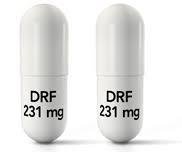Diroximel fumarate and Alcohol/Food Interactions
There are 2 alcohol/food/lifestyle interactions with diroximel fumarate.
Alcohol (Ethanol) Diroximel Fumarate
Moderate Drug Interaction
GENERALLY AVOID: Coadministration of diroximel fumarate with ethanol may reduce the plasma concentrations of monomethyl fumarate (MMF), the active metabolite of diroximel fumarate. The mechanism has not been reported. Following coadministration with 240 mL of 5% v/v and 40% v/v ethanol, the mean peak plasma concentration (Cmax) of MMF was reduced by 9% and 21%, respectively, relative to coadministration with water. The systemic exposure (AUC) of MMF was not significantly altered, indicating that ethanol did not induce dose dumping.
MANAGEMENT: The manufacturer recommends avoiding concomitant use of diroximel fumarate with ethanol.
References (3)
- (2022) "Product Information. Vumerity (diroximel fumarate)." Biogen Australia Pty Ltd
- (2022) "Product Information. Vumerity (diroximel fumarate)." Biogen Idec Ltd
- (2023) "Product Information. Vumerity (diroximel fumarate)." Biogen Idec Inc, SUPPL-9
Diroximel Fumarate Food/Lifestyle
Moderate Food Interaction
GENERALLY AVOID: Food does not significantly affect the oral bioavailability of diroximel fumarate. Administration of diroximel fumarate with a high-fat, high-calorie (900 to 1000 calories; 50% from fat) meal did not affect the systemic exposure (AUC) of its active metabolite, monomethyl fumarate (MMF), but decreased its peak plasma concentration (Cmax) by 44% and prolonged the time to reach peak concentration (Tmax) from 2.5 to 7.0 hours relative to administration in the fasted state. In comparison, administration of diroximel fumarate with low-fat, low-calorie (350 to 400 calories; 10 to 15 g fat) and medium-fat, medium-calorie (650 to 700 calories; 25 to 30 g fat) meals decreased the MMF Cmax by approximately 12% and 25%, respectively, while also leaving the AUC unaffected.
GENERALLY AVOID: Coadministration of diroximel fumarate with ethanol may reduce the plasma concentrations of monomethyl fumarate (MMF). The mechanism has not been reported. Following coadministration with 240 mL of 5% v/v and 40% v/v ethanol, the mean Cmax of MMF was reduced by 9% and 21%, respectively, relative to coadministration with water. The AUC of MMF was not significantly altered, indicating that ethanol did not induce dose dumping.
MANAGEMENT: Diroximel fumarate may be taken with or without food; however, high-fat, high-calorie meals or snacks should be avoided. The manufacturer recommends meals or snacks containing no more than 700 calories and no more than 30 grams of fat. Taking diroximel fumarate with food may improve tolerability for patients experiencing flushing or gastrointestinal adverse reactions. The manufacturer also recommends avoiding concomitant use of diroximel fumarate with ethanol.
References (3)
- (2022) "Product Information. Vumerity (diroximel fumarate)." Biogen Australia Pty Ltd
- (2022) "Product Information. Vumerity (diroximel fumarate)." Biogen Idec Ltd
- (2023) "Product Information. Vumerity (diroximel fumarate)." Biogen Idec Inc, SUPPL-9
Switch to consumer interaction data
Diroximel fumarate drug interactions
There are 645 drug interactions with diroximel fumarate.
Diroximel fumarate disease interactions
There are 5 disease interactions with diroximel fumarate which include:
More about diroximel fumarate
- diroximel fumarate consumer information
- Check interactions
- Compare alternatives
- Reviews (8)
- Side effects
- Dosage information
- During pregnancy
- Drug class: selective immunosuppressants
- Breastfeeding
- En español
Related treatment guides
Drug Interaction Classification
| Highly clinically significant. Avoid combinations; the risk of the interaction outweighs the benefit. | |
| Moderately clinically significant. Usually avoid combinations; use it only under special circumstances. | |
| Minimally clinically significant. Minimize risk; assess risk and consider an alternative drug, take steps to circumvent the interaction risk and/or institute a monitoring plan. | |
| No interaction information available. |
See also:
Further information
Always consult your healthcare provider to ensure the information displayed on this page applies to your personal circumstances.


